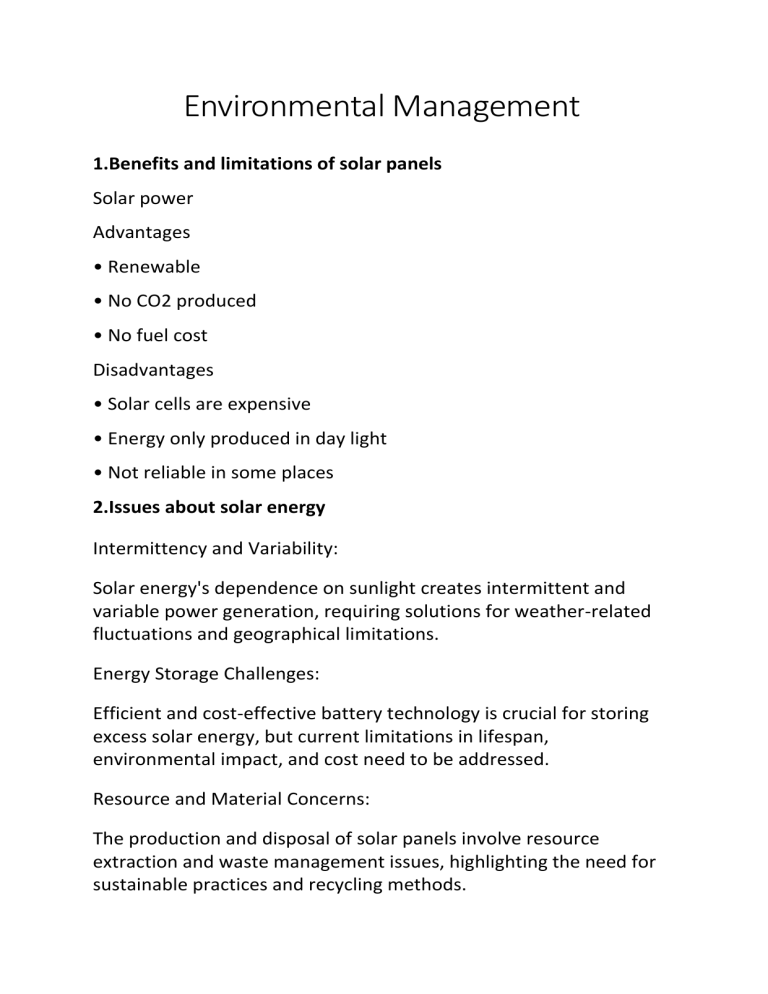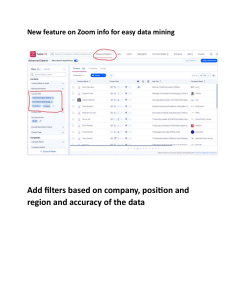Environmental Management
advertisement

Environmental Management 1.Benefits and limitations of solar panels Solar power Advantages • Renewable • No CO2 produced • No fuel cost Disadvantages • Solar cells are expensive • Energy only produced in day light • Not reliable in some places 2.Issues about solar energy Intermittency and Variability: Solar energy's dependence on sunlight creates intermittent and variable power generation, requiring solutions for weather-related fluctuations and geographical limitations. Energy Storage Challenges: Efficient and cost-effective battery technology is crucial for storing excess solar energy, but current limitations in lifespan, environmental impact, and cost need to be addressed. Resource and Material Concerns: The production and disposal of solar panels involve resource extraction and waste management issues, highlighting the need for sustainable practices and recycling methods. 4.Anaerobic Digester: Anaerobic digesters convert organic waste into biogas through a microbial process in the absence of oxygen, providing a dual benefit of renewable energy production (methane) and nutrient-rich digestate for use as fertilizer. 5.IMPACTS OF OPEN-PIT MINING ON ENVIRONMENT Air Pollution: The explosives used in blasting release fumes rich in smogand acid rain-producing gases like highly toxic nitrogen dioxide. Water Pollution: Open-pit mining often involves the use of chemicals to extract and process minerals. These chemicals, such as cyanide and heavy metals, can leach into the surrounding soil and water, contaminating aquatic ecosystems and posing risks to both human and wildlife health. Air Pollution: Dust and particulate matter generated during mining operations can contribute to air pollution. This can have respiratory and health impacts on nearby communities and may also affect vegetation in the surrounding area. 6.ISSUES EXAMPLES OF SURFACE MINING A. Open pit mining: B. Strip mining ISSUES: visual pollution • Noise pollution • Destroys habitat so reduces biodiversity • Large waste 7. TYPES OF ROCKS AND THEIR CLASSIFICATION igneous Rocks include those formed from the cooling and solidification of molten magma or lava, with classifications based on where solidification occurs, such as intrusive (e.g., granite) and extrusive (e.g., basalt). Sedimentary Rocks result from the accumulation and cementation of sediments, such as sandstone or limestone, often preserving fossils and offering insights into Earth's history. Metamorphic Rocks are created by the alteration of existing rocks through heat, pressure, or mineral-rich fluids, examples include marble (from limestone) and schist (from shale). 8. IMPACTS OF OIL SPILLS Leakage from the rigs • Leaks in the oil pipework • Risk of collision or damage to oil tanks during shipping 9.METHODS FOR DEALING WITH OIL SPILLS Use of floating booms which are floating barriers that are used to trap oil slick preventing it from spreading • Detergent sprays help break down the oil slick into smaller droplets that eventually degrade and disperse • Skimmers removes oil from seawater surface which is then scrapped of into a container


